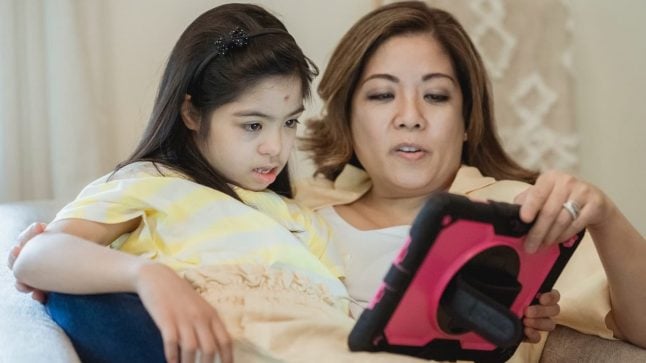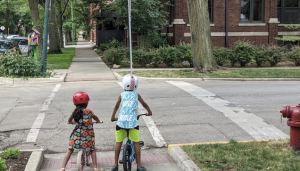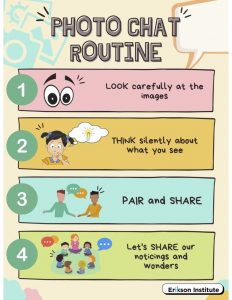Series: Ideas at Work
How to Use Digital Photos to Build a Mathematical Language Routine for Kids

What does oral language have to do with mathematics? It turns out that mathematical thinking is developed in conversation with others; asking children “how do you know that?” will reveal their mathematical reasoning skills. The ability to explain one’s thinking is a cognitive leap that requires protected time for meaningful conversation, and having a mathematical language routine can make a difference.
Oracy, or oral language development, blossoms when children have many opportunities to talk and be listened to. Young children make sense of the world through language. We use language to reason, express emotions, solve problems, and get things done! Teaching oracy means putting more intention behind how you guide and elevate your students’ math talk.
What is Photo Chat?
At Erikson’s Early Math Collaborative, we have created a mathematical language routine to incorporate all these ideas – we call it Photo Chat. It begins with a compelling photograph as a catalyst for your classroom community to chat! Digital photographs are one of the most accessible materials at our fingertips. Conversations around compelling, culturally relevant photographs build language skills that boost and help formalize mathematical thinking.
Notice & Wonder Photo Chat
Two of the most powerful questions we can ask young children are: What do you notice? and What do you wonder? To begin this routine in your classroom we recommend starting with these two questions. What students notice reveals a window into their thinking.
Prompts such as “I notice…: and “I see…” offer an entry into the chat. Children will notice various attributes and reason about what they observe. This is using math to make sense of the world!

Let’s look at a Photo Chat conversation in a Kindergarten classroom.
Notice
Antoine: I notice 2 kids riding a bike.
Dakota: They are stopped. I see a street. Maybe they see a car.
Rashawn: I notice they are riding a bike and maybe they are stopping because 2 cars are coming.
James: I see a fire hydrant.
Zoe: I see a tree. I see grass.
Karsyn: I see a birdhouse.
Genesis: I see a house.
Francois: I think they’re going to their dad’s house. It’s a boy and a girl.
Karter: I see a blue and a pink bike.
Journee: Maybe they’re going home.
Allure: I notice the kids are riding a bike and wearing flower clothes and word clothes. The girl’s shoes are different from the boy’s shoes. (sandals vs. sneakers)
Farrah: They are both wearing a helmet but the boy’s has spots.
Ideally children will pivot from first noticing to then building onto each other’s thinking. Rashawn notices the kids riding their bikes. Francois later thinks they are going to their dad’s house, and Journee thinks they may be headed home.
Once students are aware of what they notice they are primed to ask deeper questions or wonderings. The first wondering will fuel a host of other questions in the classroom. The teacher is not concerned with answering these wonderings. The purpose of wondering is to extend conversation, drive future learning and foster a community of curiosity about the world. Let’s return to the same kindergarten classroom…
Wonder
Allure: Are they going to their mom’s house? Does their dad know they are riding a bike?
Rashawn: I wonder if their dad is across the street.
James: I wonder if water will come out of that hydrant.
Zoe: I wonder if they will cross the street.
Damien: I wonder if they are going to the park.
Dakota: Maybe they are catching up with their dad to go to the pumpkin patch.
Journee: Sky Zone
Role of the Teacher
To begin this mathematical language routine in your classroom, we have created a ‘starter kit’ of Notice & Wonder photos. We encourage teachers to add photos from their community or shared classroom experiences such as field trips to their personal photo chat albums.
We encourage teachers to create a talk routine.
First students talk to a partner, a common classroom routine known as “turn and talk” before sharing with the whole class. This ensures all children get a chance to practice speaking in pairs before speaking to whole class.
Think carefully about how you will support children’s conversation.
Say what you see using descriptive language
Model precise language to describe what you see. This supports children’s receptive understanding of language.
“I notice a robin is holding a tiny, squishy worm in her beak.”
Total Physical Response (TPR) Gestures for specific academic vocabulary
Layering gestures with your words supports children’s receptive language understanding. Model for children and expect them to use the gesture, too.
A high impact strategy, especially for English Learners.
Ivette notices the baby robins have opened their beaks very wide.
Create a beak with your hand – open your hands to support the understanding of wide.
Provoke and Build the conversation
Extend and deepen the thinking or reasoning. Support language building.
“Build on’ gesture
Does anyone want to build on that?
The Value of Routines
Routines are repeated learning activities or procedures. They are powerful tools in a classroom because children are offered many opportunities to engage in an activity over time. Photo chat routines offer a playful, open-ended routine with multiple points of entry. Let’s unpack that idea: open-ended means there is more than one thing to talk about, and multiple points of entry means that students at all levels of expressive language skills will benefit from the discussion. We encourage children to express themselves in their home language and bring all their funds of knowledge to the conversation.
Once the practice of noticing and wondering becomes routine in your classroom, you are ready to ask more focused questions such as, “How are these two things the same AND different?” or “How many of what do you see?” Using a variety of questions builds a range of vocabulary and language structures needed to express comparisons and justify reasoning. Over time, photo chats grow increasingly focused on the attribute of quantity and the demand for precise language grows.
Resources
It’s easy to find online photos to start a mathematical language routine such as this. We’ve also created a starter album of images that are sure to spark conversation: Notice & Wonder Photo Album. But, the very best photos are ones that you or your families take of your local community!
Photos by Nicola Barts and Rakhee Dodia.

